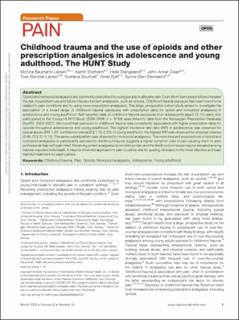| dc.contributor.author | Baumann-Larsen, Monica | |
| dc.contributor.author | Storheim, Kjersti | |
| dc.contributor.author | Stangeland, Helle | |
| dc.contributor.author | Zwart, John Anker Henrik | |
| dc.contributor.author | Wentzel-Larsen, Tore | |
| dc.contributor.author | Skurtveit, Svetlana Ondrasova | |
| dc.contributor.author | Dyb, Grete Anita | |
| dc.contributor.author | Stensland, Synne | |
| dc.date.accessioned | 2024-02-21T12:25:33Z | |
| dc.date.available | 2024-02-21T12:25:33Z | |
| dc.date.created | 2023-12-22T09:26:50Z | |
| dc.date.issued | 2023 | |
| dc.identifier.issn | 0304-3959 | |
| dc.identifier.uri | https://hdl.handle.net/11250/3119023 | |
| dc.description.abstract | Opioid and nonopioid analgesics are commonly prescribed to young people to alleviate pain. Even short-term prescriptions incr
the risk of persistent use and future misuse of potent analgesics, such as opioids. Childhood trauma exposure has been found to be related to pain conditions and to using more prescription analgesics. This large, prospective cohort study aimed to investigate the association of a broad range of childhood trauma exposures with prescription rates for opioid and nonopioid analgesics in adolescence and young adulthood. Self-reported data on childhood trauma exposures from adolescents (aged 13-19 years) who participated in the Young-HUNT3 Study (2006-2008, n 5 8199) were linked to data from the Norwegian Prescription Database (NorPD, 2004-2021). We found that exposure to childhood trauma was consistently associated with higher prescription rates for opioids throughout adolescence and young adulthood. The highest incidence rate ratio (IRR) in adolescence was observed for sexual abuse (IRR 1.63, confidence interval [CI] 1.19-2.23). In young adulthood, the highest IRR was observed for physical violence (2.66, CI 2.27-3.12). The same overall pattern was observed for nonopioid analgesics. The more frequent prescriptions of opioid and nonopioid analgesics to participants exposed to childhood trauma suggests a higher symptom load of pain causing them to seek professional help with pain relief. Receiving potent analgesics is not without risk, and the likelihood of misuse may be elevated among trauma-exposed individuals. A trauma-informed approach to pain could be vital for guiding clinicians to the most effective and least harmful treatment for each patient. | en_US |
| dc.language.iso | eng | en_US |
| dc.rights | Attribution-NonCommercial-NoDerivatives 4.0 Internasjonal | * |
| dc.rights.uri | http://creativecommons.org/licenses/by-nc-nd/4.0/deed.no | * |
| dc.title | Childhood trauma and the use of opioids and other prescription analgesics in adolescence and young adulthood | en_US |
| dc.type | Journal article | en_US |
| dc.type | Peer reviewed | en_US |
| dc.description.version | publishedVersion | en_US |
| cristin.ispublished | true | |
| cristin.fulltext | original | |
| cristin.qualitycode | 2 | |
| dc.identifier.doi | 10.1097/j.pain.0000000000003131 | |
| dc.identifier.cristin | 2217125 | |
| dc.source.journal | Pain | en_US |
| dc.relation.project | Norges forskningsråd: 320360 | en_US |

